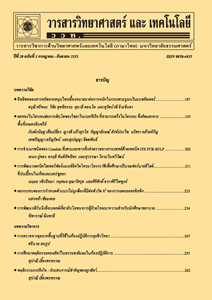การออกแบบอุปกรณ์ AWG ที่มีขนาดเล็กสำหรับระบบ WDM
Main Article Content
Abstract
บทคัดย่อ
บทความนี้นำเสนอการออกแบบอุปกรณ์ arrayed waveguide grating (AWG) ที่มีขนาดเล็กเพื่อประยุกต์ใช้ในระบบ wavelength division multiplexing (WDM) โดยผู้วิจัยได้ทำการปรับลดขนาดทางกายภาพของอุปกรณ์ AWG ตัวต้นแบบด้วยการปรับลดจำนวน arrayed waveguide จากจำนวน 4 เท่า เป็น 2 เท่า ของจำนวนช่อง สัญญาณขาออก และทำการปรับลดความสูงของบริเวณ free propagation region ที่หนึ่ง (FPR 1) ให้มีค่าเพียงพอต่อการรองรับการกระจายตัวของแสงส่วนใหญ่ภายในบริเวณ FPR 1 จากการปรับลดโครงสร้างดังกล่าวทำให้อุปกรณ์ AWG ที่ได้มีขนาดเพียงครึ่งหนึ่งของ AWG ตัวต้นแบบ อย่างไรก็ตามอุปกรณ์ AWG ที่ได้ออกแบบมีค่าความสูญเสียเชิงแสงสูงกว่าของอุปกรณ์ AWG ตัวต้นแบบ โดยอุปกรณ์ AWG ที่ได้ออกแบบมีค่า insertion loss เท่ากับ 2.260 dB และมีค่า crosstalk เท่ากับ -22.565 dB ในขณะที่อุปกรณ์ AWG ตัวต้นแบบมีค่า insertion loss เท่ากับ 1.763 dB และมีค่า crosstalk เท่ากับ -25.179 dB ดังนั้นเพื่อเป็นการลดค่าความสูญเสียเชิงแสงที่สูงขึ้นจากการปรับลดขนาดทางกายภาพ ผู้วิจัยจึงได้ทำการเพิ่มความกว้างของ waveguide บริเวณ arrayed waveguide จาก 6 ไมโครเมตร เป็น 8 ไมโครเมตร เพื่อลดช่องว่างระหว่าง waveguide บริเวณ arrayed waveguide นอกจากนี้ได้ปรับเพิ่มค่าดรรชนีหักเหบริเวณ FPR1 จาก 1.455 เป็น 1.458 เพื่อลดการกระจายตัวของแสงในบริเวณ FPR1 ซึ่งจากการออกแบบเพิ่มเติมในลักษณะดังกล่าว ทำให้แสงส่วนใหญ่จากบริเวณ FPR1 สามารถเดินทางเข้าสู่บริเวณ arrayed waveguideได้มากขึ้นและทำให้ความสูญเสียเชิงแสงที่เกิดขึ้นมีค่าลดลง โดยค่า insertion loss ลดลงจาก 2.260 dB เป็น 1.749 dB และค่า crosstalk เปลี่ยนแปลงจากค่า -22.565 dB เป็น -22.545 dB ดังนั้นจากการทำตามขั้นตอนดังกล่าวทั้งหมด ทำให้อุปกรณ์ AWG ที่ได้มีขนาดครึ่งหนึ่งและมีค่าความสูญเสียเชิงแสงใกล้เคียงกับอุปกรณ์ AWG ตัวต้นแบบ ทำให้ผู้วิจัยคาดหวังว่าอุปกรณ์ AWG ดังกล่าวสามารถนำไปประยุกต์ใช้งานได้จริงในระบบ WDM ต่อไป
คำสำคัญ : อุปกรณ์ arrayed waveguide grating (AWG); ระบบ wavelength division multiplexing (WDM); บริเวณ free propagation region ที่หนึ่ง (FPR 1); ความสูญเสียเชิงแสง; ค่าดัชนีหักเห
Abstract
This paper proposes the innovative design concept of arrayed waveguide grating (AWG) with small size for wavelength division multiplexing (WDM) system. In this research; the physical dimension of traditional AWG structure is reduced by decreasing arrayed waveguide number from 4 times to 2 times larger than output waveguide number; and it is also reduced by decreasing the height of first free propagation region (FPR 1). Here; the height of FPR 1 is designed to be the appropriate value to receive the majority light expanded inside FPR 1. By decreasing these two parts; the size of the proposed AWG becomes the half size of the traditional AWG. However; the optical loss of the proposed AWG is higher than that of the traditional AWG. Here; the insertion loss and the crosstalk of the proposed AWG are 2.260 dB and -22.565 dB; while those of the traditional structure are 1.763 dB and -25.179 dB; respectively. In order to reduce the increased level of optical loss due to the reduction of physical dimension of traditional AWG; the width of waveguide in arrayed waveguide region is increased from 6 mm to 8 mm to decrease the gap between two waveguides. Moreover; the refractive index of FPR 1 is increased from 1.455 to 1.458 in order to reduce the light expanding inside FPR1. Using these two design concepts; the higher level of majority light from FPR 1 can travel through arrayed waveguide region; and the optical loss can be reduced significantly. Then; the insertion loss of the proposed AWG is decreased from 2.260 dB to 1.749 dB and the crosstalk is changed from -22.565 dB to -22.545 dB; respectively. Therefore; the appropriate structure of proposed AWG can be achieved. Here; the size of the proposed AWG is the half size of the traditional AWG; and the optical loss characteristics of the proposed AWG are very close to those of the traditional AWG. Finally; this proposed AWG can be expected for the application in an actual WDM system.
Keywords: arrayed waveguide grating (AWG); wavelength division multiplexing (WDM); free propagation region 1 (FPR1); optical loss; refractive index


